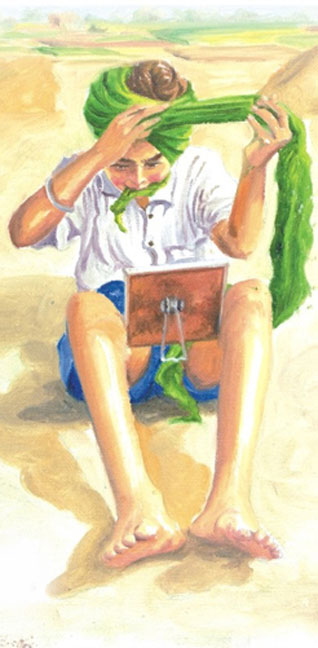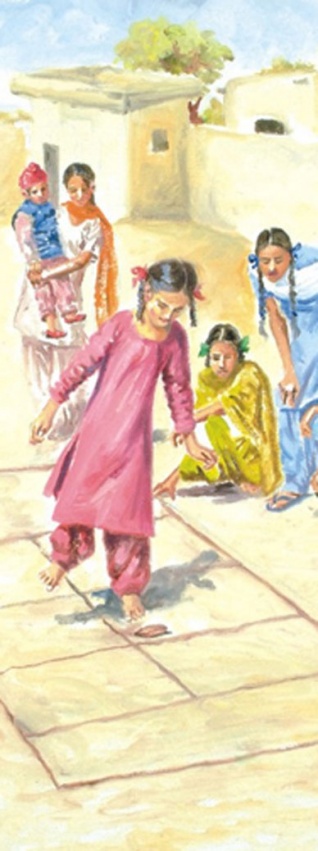People
The Punjabi In Me
HARINDER SINGH, SikhRI
Did I ever leave Punjab?
Growing up in the West, my earliest memory of Punjab is taking a train ride from Jhansi (Uttar Pradesh, India) to Ludhiana (Punjab) during summer breaks to visit my naanke (maternal grandparents).
There are also fond memories of trips with my family to mostly East, and one to West Punjab, in June 1984. On an extended stay away from the homeland thereafter, as if in exile, my connection with Punjab came via books and songs in Kansas, USA.
Those were the years of high school, university, and an aviation career. Bhai Vir Singh, Prof. Puran Singh and Harinder Singh Mehboob watered my roots with nourishment from the ‘land of five rivers,’ as did Nusrat Fateh Ali Khan, Kuldip Manak, and the Safri Boys.
After a gap of more than a decade, a trip back to East Punjab in 1997 brought back many of these dormant memories.
Staying back in East Punjab for five years, I discovered many Punjabi layers: people, psyche, past. It was a ‘road less traveled’ winding through pinds (villages) and saaths (hangout), coming across folksingers like Sharif Uddu and incredible kirtaniya (spiritual minstrel) Bhai Balbir Singh, life-long friendships with founders of the now world-famous 1469 stores and The Panjab Digital Library, listening to stories of survivors and respondents of 1984 and their advocates, connecting with the youth on campuses and Barista, listening to the sounds of Vismaad Naad to Naad Pargaas, savoring the culinary delights at Kesar da dhaba and savouring gol guppey galore.
It was a powerful journey that moved me back to my origin and connected me with the land and its people. To top it all, I met my life-partner in Punjab, while both of us were volunteering at an NGO, FATEH, a Sikh version of the Peace Corps.
After returning from East Punjab in 2002, several trips to West Punjab, made all the way from Texas, added to the color and vastness of the land I already loved by, for example, discovering the likes of the bard, Alam Lohar. Language, culture, music, food, as weel as the literal and figurative discovery of new dimensions of lok virsa (folk culture), in an area where the world’s largest Punjabi population resides … on the west side of Wagah.
Punjab as a space has special place for me. As a foot-soldier in Guru Nanak’s revolution, I am on a continuous journey from Karatarpur to Anandpur with several stops at Sirhind, Amritsar, Lahore, Nankana, and Jamraud. An experiential journey through Prof. Puran Singh’s ‘Desh Punjab‘ where the unions and separations are as grand as its rivers.
Its youth, though stubborn, is always ready to give its life in love. This river is now dry, divided. How do I flow to become deep, wide, quite, yet intense?
I long to go back to the unbound, undivided Panjab. I yearn to weave it into my being like a phulkari; vibrant, colorful, diverse, embracing within itself myriad manifested shades of a woman’s rich emotions.
As a folk art, Phulkari was very personal, embroidered by Punjabi women for their familial use. It exemplified and externalized the urge for creativity to make life more colorful. For me, Phulkari is an analogy to view the undivided pre-partition Punjab that looked like a titlee (butterfly).
How can a titlee, despite all of its wondrous colors, take flight when its wings are clipped?
In the last 75 years, our creative instincts have slowly shrunk like a dying titlee. Phulkari’s revival may propel us 120 million global Punjabi titlees to smell the fragrance of the flowers. And perhaps, implore us to revive the garden of diverse and rich life, our own Phulkari.
Spring (basant) 2015 is time to connect my two divine gifts (5 year old daughter and 7 year old son) in New Jersey to Old Punjab. My wife and I dream for them to become part of this Phulkari.
Will my kids hear Dhani Ram Chatrik’s “damaame” in celebration of life’s mela? Will my kids answer Amrita Pritam’s “kook” (clarion call) for Panjab’s daughters? Will my kids relate to the “hu” of Sulta Bahu to become divine lovers? I ask these and many other questions.
My Sovereign, Guru Gobind Singh was not born in Punjab. His journey to Punjab from Patna (Bihar) is a reminder to me of my journey from the diaspora to the homeland. On this path, I long for the real punjabiyat (Punjabi-ness), where diversity and multiculturalism were not mere slogans, but a reality. Now, they are seamlessly reminisced via dhol and bhangra, while giddaa and jhumar elope.
“Long live the Nation of The Five Rivers” – this was the official soldier’s salutation used to greet an army commander in the Kingdom of Punjab under Maharaja Ranjit Singh. What’s my salutation to replenish the now barren and poisoned land which our foremothers and forefathers inhabited?
I ponder. With such thoughts and emotions, I let loose the titlee in me to take a phulkari flight!
April 8, 2015
Conversation about this article
1: Brig. Nawab Singh Heer (Ret.) (New York, USA), April 08, 2015, 9:24 PM.
Harinder ji: Your narrative has taken us down memory lane. I too miss my Punjab-tobbe, tinda-wala-khu, sarson da saag te makki-di-roti, moving bare-footed, bhatti-de-daane, fresh gurrh and shakkar, roori-marka-sarab, basant-da-mela, kabbaddi and wrestling, three day-barats, kohlu ride, sawan di peeng, bhade-janna, bhua de paranthe, etc., etc. I too miss Preet-Larri, Shiv Kumar Batalvi, Amrita Pritam, Nanak Singh and Kanwal. I miss gurdwara speakers at 4 am and sangrand da parshad. I miss kothe te sonaa, chacche dian baatan, kaveeshars, Bhagat Singh's inspiration ... Well, my son living in Toronto and my daughter in Canberra, will they ever get those feelings? I suppose change is the only constant, otherwise, everything changes. Deep down in their subconsciousness, they will have a place for those memories and experiences at times, I'm sure. At least as long as I live, I can feel the mud from my village, the fragrance of fresh air, the taste of the water from the hand pump, the scenic view of sarson fields and the walk along the village phirny -- all of these will remain fresh with me. With a prayer and hope that my Punjab revives its lost glory, so that my children can enjoy it as much, and be nurtured by it as I did.




